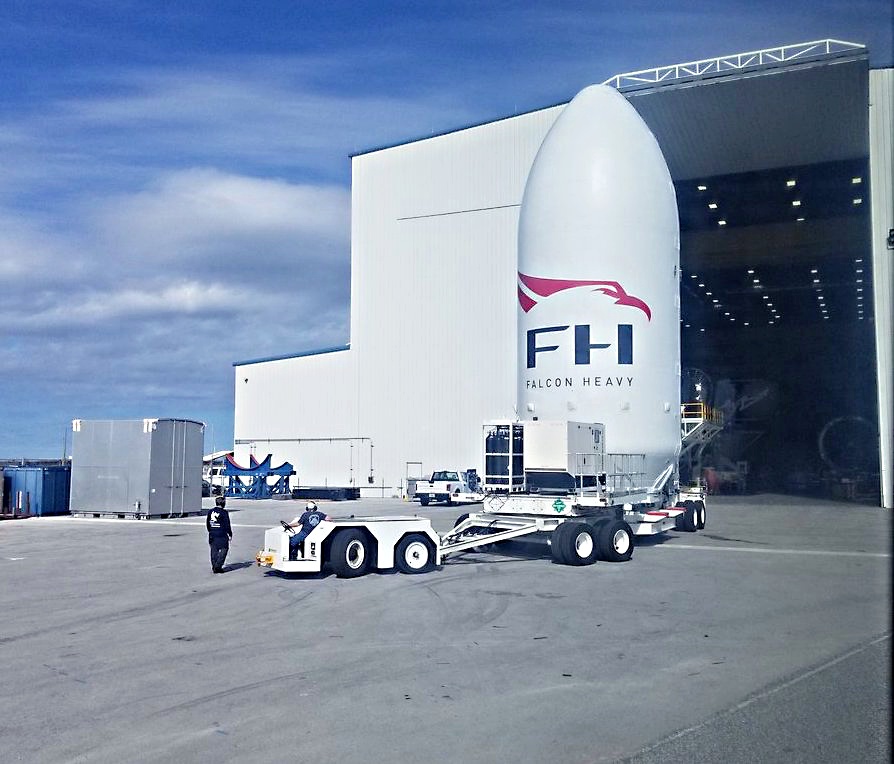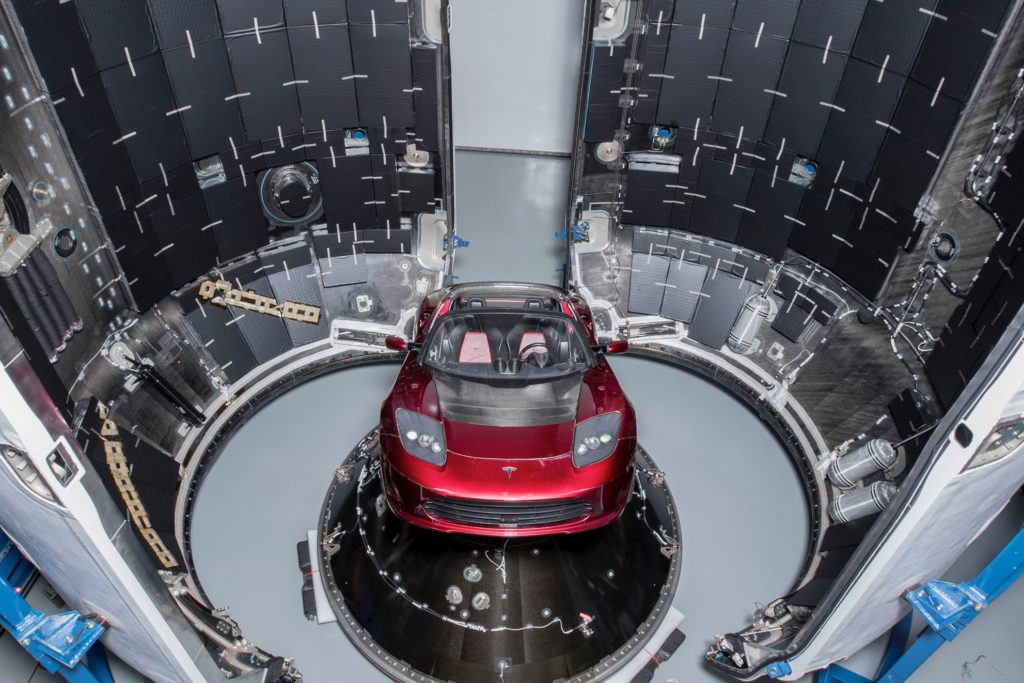

News
SpaceX’s Falcon Heavy payload fairing spotted ahead of its maiden launch
By now, we know Elon Musk wasn’t joking when he announced that the maiden flight of SpaceX’s Falcon Heavy rocket would feature his very own Tesla Roadster as its first payload. Just recently, images of the electric car being installed inside the payload fairing of the massive rocket emerged online. Now, a new picture has been shared on Twitter, seemingly depicting the FH’s completed fairing as it was being transported inside a hangar in NASA’s Kennedy Space Center.
The image tweeted by Emiliano C. Diaz de Leon, who snapped the photo during a bus tour of the facility. According to Diaz de Leon, he and his family were fortunate enough to get a good glimpse of the Falcon Heavy’s payload fairing when the space center’s bus tours stopped by the SpaceX hangar. It was then that he was able to snap a photo of the Falcon Heavy’s second stage.

[Credit: @ECDiazdeLeon via Twitter]
Falcon Heavy is SpaceX’s most ambitious rocket to date, designed to carry heavy payloads. Its maiden mission, sending the SpaceX founder’s Tesla Roadster to space, is expected to be conducted sometime around January 2018. Other details of the upcoming launch, however, such as its official time and the rocket’s designated pad, have not been released.

Elon Musk’s Midnight Cherry Roadster inside Falcon Heavy ready for its Mars-bound journey. [Full gallery]
In true Elon Musk fashion, several interesting items would be sent with the Tesla Roadster to space. According to the SpaceX CEO, the electric sports car would be accompanied on its final journey by a copy of Douglas Adams’ “The Hitchhiker’s Guide to the Galaxy,” a towel, a sign that reads “Don’t Panic,” and a track that plays David Bowie’s iconic chart-topping track, “Space Oddity.” These items, together with the Roadster, would likely be sent to deep space, where it would hopefully enter Mars orbit.
https://twitter.com/ECDiazdeLeon/status/945692630062690304
With the most recent sighting of the Falcon Heavy’s payload fairing in mind, all signs seem to be pointing to the idea that SpaceX is already assembling both stages of its largest and most ambitious rocket. As revealed in a series of image updates by Elon Musk, the majority of the Falcon Heavy is already at Cape Canaveral, FL, and all three of its first stages have been mated together. Considering that the payload fairing has been spotted as well, the Falcon Heavy might be ready for some real testing soon.
The Falcon Heavy holds the potential to be a true game-changer in the commercial space industry, with its first stage being made up of 27 Merlin engines from three Falcon 9 cores. According to SpaceX, the configuration will allow the rocket to generate more than 5 million pounds of thrust at liftoff, the same thrust as fifteen 747 jumbo jets at full throttle. The Falcon Heavy is also capable of transporting more than 140,000 pounds of cargo, which is more than twice the payload capacity of the Delta IV Heavy rocket, the FH’s closest competitor.
SpaceX initially unveiled the Falcon Heavy back in 2011, with a tentative 2013 maiden launch date. Due to a series of issues with several Falcon 9 rockets, however, the debut of the Falcon Heavy was continually pushed back. Nevertheless, despite being several years late from its initial 2013 estimate, the Falcon Heavy’s imminent launch this January 2018 definitely seems to be well worth the wait.

Elon Musk
Elon Musk’s X will start using a Tesla-like software update strategy
The initiative seems designed to accelerate updates to the social media platform, while maintaining maximum transparency.

Elon Musk’s social media platform X will adopt a Tesla-esque approach to software updates for its algorithm.
The initiative seems designed to accelerate updates to the social media platform, while maintaining maximum transparency.
X’s updates to its updates
As per Musk in a post on X, the social media company will be making a new algorithm to determine what organic and advertising posts are recommended to users. These updates would then be repeated every four weeks.
“We will make the new 𝕏 algorithm, including all code used to determine what organic and advertising posts are recommended to users, open source in 7 days. This will be repeated every 4 weeks, with comprehensive developer notes, to help you understand what changed,” Musk wrote in his post.
The initiative somewhat mirrors Tesla’s over-the-air update model, where vehicle software is regularly refined and pushed to users with detailed release notes. This should allow users to better understand the details of X’s every update and foster a healthy feedback loop for the social media platform.
xAI and X
X, formerly Twitter, has been acquired by Elon Musk’s artificial intelligence startup, xAI last year. Since then, xAI has seen a rapid rise in valuation. Following the company’s the company’s upsized $20 billion Series E funding round, estimates now suggest that xAI is worth tens about $230 to $235 billion. That’s several times larger than Tesla when Elon Musk received his controversial 2018 CEO Performance Award.
As per xAI, the Series E funding round attracted a diverse group of investors, including Valor Equity Partners, Stepstone Group, Fidelity Management & Research Company, Qatar Investment Authority, MGX, and Baron Capital Group, among others. Strategic partners NVIDIA and Cisco Investments also continued support for building the world’s largest GPU clusters.
News
Tesla FSD Supervised wins MotorTrend’s Best Driver Assistance Award
The decision marks a notable reversal for the publication from prior years, with judges citing major real-world improvements that pushed Tesla’s latest FSD software ahead of every competing ADAS system.

Tesla’s Full Self-Driving (Supervised) system has been named the best driver-assistance technology on the market, earning top honors at the 2026 MotorTrend Best Tech Awards.
The decision marks a notable reversal for the publication from prior years, with judges citing major real-world improvements that pushed Tesla’s latest FSD software ahead of every competing ADAS system. And it wasn’t even close.
MotorTrend reverses course
MotorTrend awarded Tesla FSD (Supervised) its 2026 Best Tech Driver Assistance title after extensive testing of the latest v14 software. The publication acknowledged that it had previously criticized earlier versions of FSD for erratic behavior and near-miss incidents, ultimately favoring rivals such as GM’s Super Cruise in earlier evaluations.
According to MotorTrend, the newest iteration of FSD resolved many of those shortcomings. Testers said v14 showed far smoother behavior in complex urban scenarios, including unprotected left turns, traffic circles, emergency vehicles, and dense city streets. While the system still requires constant driver supervision, judges concluded that no other advanced driver-assistance system currently matches its breadth of capability.
Unlike rival systems that rely on combinations of cameras, radar, lidar, and mapped highways, Tesla’s FSD operates using a camera-only approach and is capable of driving on city streets, rural roads, and freeways. MotorTrend stated that pure utility, the ability to handle nearly all road types, ultimately separated FSD from competitors like Ford BlueCruise, GM Super Cruise, and BMW’s Highway Assistant.
High cost and high capability
MotorTrend also addressed FSD’s pricing, which remains significantly higher than rival systems. Tesla currently charges $8,000 for a one-time purchase or $99 per month for a subscription, compared with far lower upfront and subscription costs from other automakers. The publication noted that the premium is justified given FSD’s unmatched scope and continuous software evolution.
Safety remained a central focus of the evaluation. While testers reported collision-free operation over thousands of miles, they noted ongoing concerns around FSD’s configurable driving modes, including options that allow aggressive driving and speeds beyond posted limits. MotorTrend emphasized that, like all Level 2 systems, FSD still depends on a fully attentive human driver at all times.
Despite those caveats, the publication concluded that Tesla’s rapid software progress fundamentally reshaped the competitive landscape. For drivers seeking the most capable hands-on driver-assistance system available today, MotorTrend concluded Tesla FSD (Supervised) now stands alone at the top.
News
Elon Musk’s Grokipedia surges to 5.6M articles, almost 79% of English Wikipedia
The explosive growth marks a major milestone for the AI-powered online encyclopedia, which was launched by Elon Musk’s xAI just months ago.

Elon Musk’s Grokipedia has grown to an impressive 5,615,201 articles as of today, closing in on 79% of the English Wikipedia’s current total of 7,119,376 articles.
The explosive growth marks a major milestone for the AI-powered online encyclopedia, which was launched by Elon Musk’s xAI just months ago. Needless to say, it would only be a matter of time before Grokipedia exceeds English Wikipedia in sheer volume.
Grokipedia’s rapid growth
xAI’s vision for Grokipedia emphasizes neutrality, while Grok’s reasoning capabilities allow for fast drafting and fact-checking. When Elon Musk announced the initiative in late September 2025, he noted that Grokipedia would be an improvement to Wikipedia because it would be designed to avoid bias.
At the time, Musk noted that Grokipedia “is a necessary step towards the xAI goal of understanding the Universe.”
Grokipedia was launched in late October, and while xAI was careful to list it only as Version 0.1 at the time, the online encyclopedia immediately earned praise. Wikipedia co-founder Larry Sanger highlighted the project’s innovative approach, noting how it leverages AI to fill knowledge gaps and enable rapid updates. Netizens also observed how Grokipedia tends to present articles in a more objective manner compared to Wikipedia, which is edited by humans.
Elon Musk’s ambitious plans
With 5,615,201 total articles, Grokipedia has now grown to almost 79% of English Wikipedia’s article base. This is incredibly quick, though Grokipedia remains text-only for now. xAI, for its part, has now updated the online encyclopedia’s iteration to v0.2.
Elon Musk has shared bold ideas for Grokipedia, including sending a record of the entire knowledge base to space as part of xAI’s mission to preserve and expand human understanding. At some point, Musk stated that Grokipedia will be renamed to Encyclopedia Galactica, and it will be sent to the cosmos.
“When Grokipedia is good enough (long way to go), we will change the name to Encyclopedia Galactica. It will be an open source distillation of all knowledge, including audio, images and video. Join xAI to help build the sci-fi version of the Library of Alexandria!” Musk wrote, adding in a later post that “Copies will be etched in stone and sent to the Moon, Mars and beyond. This time, it will not be lost.”








